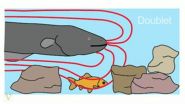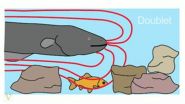Click here for more information.
The electric eel - the scaleless Amazonian fish that can deliver an electrical jolt strong enough to knock down a full-grown horse - possesses an electroshock system uncannily similar to a Taser.
That is the conclusion of a nine-month study of the way in which the electric eel uses high-voltage electrical discharges to locate and incapacitate its prey. The research was conducted by Vanderbilt University Stevenson Professor of Biological Sciences Kenneth Catania and is described in the article "The shocking predatory strike of the electric eel" published in the Dec. 5 issue of the journal Science.
People have known about electric fish for a long time. The ancient Egyptians used an electric marine ray to treat epilepsy. Michael Faraday used eels to investigate the nature of electricity and eel anatomy helped inspire Volta to create the first battery. Biologists have determined that a six-foot electric eel can generate about 600 volts of electricity - five times that of a U.S. electrical outlet. This summer scientists at the University of Wisconsin-Madison announced that they had sequenced the complete electric eel genome.
Until now, however, no one had figured out how the eel's electroshock system actually worked. In order to do so, Catania equipped a large aquarium with a system that can detect the eel's electric signals and obtained several eels, ranging up to four feet in length.
As he began observing the eels' behavior, the biologist discovered that their movements are incredibly fast. They can strike and swallow a worm or small fish in about a tenth of a second. So Catania rigged up a high-speed video system that ran at a thousand frames per second so he could study the eel's actions in slow motion. Catania recorded three different kinds of electrical discharges from the eels: low-voltage pulses for sensing their environment; short sequences of two or three high-voltage millisecond pulses (called doublets or triplets) given off while hunting; and volleys of high-voltage, high-frequency pulses when capturing prey or defending themselves from attack.
He found that the eel begins its attack on free-swimming prey with a high-frequency volley of high-voltage pulses about 10 to 15 milliseconds before it strikes. In the high-speed video, it became apparent that the fish were completely immobilized within three to four milliseconds after the volley hit them. The paralysis was temporary: If the eel didn't immediately capture a fish, it normally regained its mobility after a short period and swam away.
"It's amazing. The eel can totally inactivate its prey in just three milliseconds. The fish are completely paralyzed," said Catania.
These observations raised an obvious question: How do the eels do it? For that, there was no clear answer in the scientific literature.
"I have some friends in law enforcement, so I was familiar with how a Taser works," said Catania. "And I was struck by the similarity between the eel's volley and a Taser discharge. A Taser delivers 19 high-voltage pulses per second while the electric eel produces 400 pulses per second."
The Taser works by overwhelming the nerves that control the muscles in the target's body, causing the muscles to involuntarily contract. To determine if the eel's electrical discharge had the same effect, Catania walled off part of the aquarium with an electrically permeable barrier. He placed a pithed fish on other side of the barrier from the eel and then fed the eel some earthworms, which triggered its electrical volleys. The volleys that passed through the barrier and struck the fish produced strong muscle contractions.
To determine whether the discharges were acting on the prey's motor neurons - the nerves that control the muscles - or on the muscles themselves, he placed two pithed fish behind the barrier: one injected with saline solution and other injected with curare, a paralytic agent that targets the nervous system. The muscles of the fish with the saline continued to contract in response to the eel's electrical discharges but the muscle contractions in the fish given the curare disappeared as the drug took effect. This demonstrated that the eel's electrical discharges were acting through the motor neurons just like Taser discharges.
Next Catania turned his attention to the way in which the eel uses electrical signals for hunting. The eel is nocturnal and doesn't have very good eyesight. So it needs other ways to detect hidden prey.
The biologist determined that the closely space doublets and triplets that the eel emits correspond to the electric signal that motor neurons send to muscles to produce an extremely rapid contraction.
"Normally, you or I or any other animal can't cause all of the muscles in our body to contract at the same time. However, that is just what the eel can cause with this signal," Catania said.
Putting together the fact that the eels are extremely sensitive to water movements with the fact that the whole-body muscle contraction causes the prey's body to twitch, creating water movements that the eel can sense, Catania concluded that the eel is using these signals to locate hidden prey.
To test this hypothesis, Catania connected a pithed fish to a stimulator.. He put the fish in a clear plastic bag to protect it from the eel's emissions. He found that when he stimulated the fish to twitch right after the eel emitted one of its signals, the eel would attack. But, when the fish failed to respond to its signal, the eel did not attack. The result supports the idea that the eel uses its electroshock system to force its prey to reveal their location.
"If you take a step back and think about it, what the eel can do is extremely remarkable," said Catania. "It can use its electrical system to take remote control of its prey's body. If a fish is hiding nearby, the eel can force it to twitch, giving away its location, and if the eel is ready to capture a fish, it can paralyze it so it can't escape."
INFORMATION:
The research was funded by a Pradel Award from the National Academy of Sciences, a Guggenheim fellowship and National Science Foundation grant 0844743.
Visit Research News @ Vanderbilt for more research news from Vanderbilt. [Media Note: Vanderbilt has a 24/7 TV and radio studio with a dedicated fiber optic line and ISDN line. Use of the TV studio with Vanderbilt experts is free, except for reserving fiber time.] END





